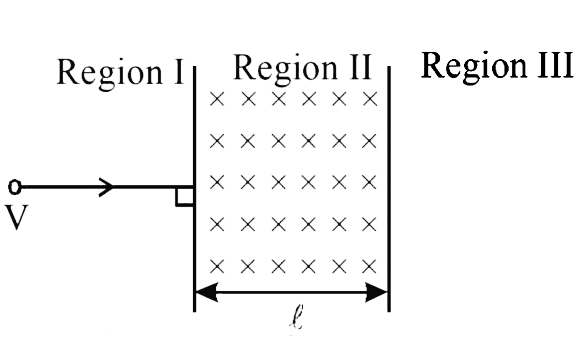A particle with charge g and mass m is moving with velocity V ,normal to the boundary of the thin region of uniform magnetic field, applied perpendicular to the velocity as shown in the figure. Width of the region is d.

Particle will deviate by 180∘ if V<qBdm
Particle will deviate by 90∘ if velocity is slightly greater than qBdm
Particle will not come back if V>qBdm
Angle of deviation will be less than 90∘ if V>qBdm
The correct Answer is:a, b, c, d
The particle is going to follow a circular path and its radius inside the field can be written as follows:
r=mVqB
If within the region of the magnetic field, the particle is able to complete its quarter circle, then it is going to come back and emerge back in the opposite direction (deviation of 180∘) at a distance 2r from the point of entry. For this to happen r=mVqB<d⇒V<qBdm . Hence option (a) is correct.
When the velocity of the particle is only slightly greater than qBdm then the radius of the circle will be only slightly greater than d. As soon as the particle completes a quarter circle, then it comes out of the field and hence the angle of deviation remains 90∘ .
When the velocity of the particle is greater than qBdm then the radius of the circle will be thand, which is the width of the magnetic field. In this case, the particle will not be able to complete a quarter circle and will cross to the other side and not come back to this side. Hence option (c) is correct. Option (d) is also correct because in this case, the angle of deviation will be less than 90∘.
All are correct.
Topper's Solved these Questions
- MOVING CHARGES AND MAGNETISMBOOK - MODERN PUBLICATIONCHAPTER - MOVING CHARGES AND MAGNETISMEXERCISE - COMPETITION FILE (D. MULTIPLE CHOICE QUESTIONS)
10 Videos
- MOVING CHARGES AND MAGNETISMBOOK - MODERN PUBLICATIONCHAPTER - MOVING CHARGES AND MAGNETISMEXERCISE - COMPETITION FILE (ASSERTION TYPE QUESTIONS)
10 Videos
- MOVING CHARGES AND MAGNETISMBOOK - MODERN PUBLICATIONCHAPTER - MOVING CHARGES AND MAGNETISMEXERCISE - COMPETITION FILE (B. MULTIPLE CHOICE QUESTIONS)
79 Videos
- MAGNETISM AND MATTERBOOK - MODERN PUBLICATIONCHAPTER - MAGNETISM AND MATTEREXERCISE - CHAPTER PRACTICE TEST FOR BOARD EXAMINATION
16 Videos
- NUCLEIBOOK - MODERN PUBLICATIONCHAPTER - NUCLEIEXERCISE - CHAPTER PRACTICE TEST FOR BOARD EXAMINATION
15 Videos
Similar Questions
A particle of mass mand charge q, moving with velocity v enters Region II normal to the boundary as shown in the figure. Region II has a uniform magnetic field B perpendicular to the plane of the paper . The length of the region II is l. Choose the correct choice(s).

View SolutionA particle of mass m and charge q, moving with velocity v enters region II normal to the boundary as shown in the figure. Region II has a uniform magnetic field B perpendicular to plane of the paper. The length of the Region II is l.. Choose the correct choice (s):

View Solution
Knowledge Check
A particle of mass mand charge q, moving with velocity v enters Region II normal to the boundary as shown in the figure. Region II has a uniform magnetic field B perpendicular to the plane of the paper . The length of the region II is l. Choose the correct choice(s).
 AThe particle enters Region III only if its velocity v<qlBmBThe particle enters Region III only if its velocity v>qlBmCPath length of the particle in Region II is maximum when velocity v=qlBmDTime spent in Region II is same for any velocity v as long as the particle returns to Region I
AThe particle enters Region III only if its velocity v<qlBmBThe particle enters Region III only if its velocity v>qlBmCPath length of the particle in Region II is maximum when velocity v=qlBmDTime spent in Region II is same for any velocity v as long as the particle returns to Region IA particle of charge q and mass m moving with a velocity v along the x-axis enters the region x>0 with uniform magnetic field B along the ˆk direction. The particle will penetrate in this region in the x-direction upto a distance d equal to
AZeroBmvqBC2mvqBDinfinityThere is a beam of electrons and protons in which both the particles are moving with the same velocity, entering a thin region, where a uniform magnetic field is applied perpendicular to the motion of beam. The protons and the electrons
Awill be deviated in the same directionBwill be deviated in opposite directions with a different angle of deviationCwill be deviated in an opposite direction with a same angle of deviationDwill not deviate
A particle of charge q and mass m moving with a velocity v along the x-axis enters the region x>0 with uniform magnetic field B along the ˆk direction. The particle will penetrate in this region in the x-direction upto a distance d equal to
View SolutionA proton and an electron both moving with the same velocity v enter into a region of magnetic field directed perpendicular to the velocity of the particles. They will now move in cirular orbits such that
View SolutionA particle of mass m and charge q moving with velocity v enters the region of uniform magnetic field at right angle to the direction of its motion. How does its kinetic energy get affected?
View SolutionAn ion of charge + g and mass m is accelerated in a region of potential difference V volts and then it enters a region of uniform magnetic field B perpendicular to its velocity. If the ion describes a semicircle of diameter x, then its mass m is
View SolutionA proton and an electron both moving with the same velocity v enter into a region of magnetic field directed perpendicular to the velocity of the particles. They will now move in cirular orbits such that
View Solution
